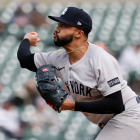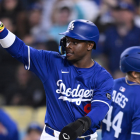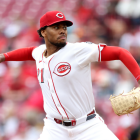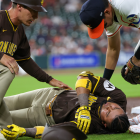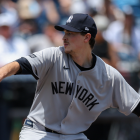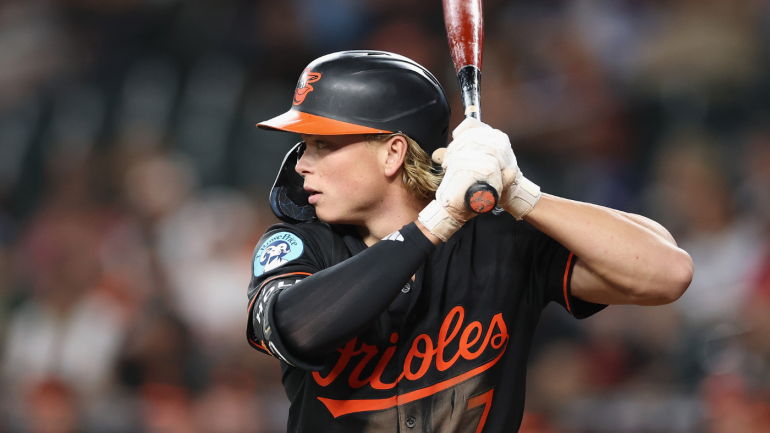
The 2025 MLB regular season is less than two weeks old and you have my full permission to use "it's still early" if things aren't going your way for your favorite team or player. It is early! It is so, so, early. If the 162-game season were a nine-inning game, there would be one out in the bottom of the first inning right now. It is a long season, folks. A very long season.
It may still be early, but there are a few things we can gleam from the little bit of baseball that has been played. Here now are three trends worth knowing one day short of two weeks into the new season.
Holliday's adjustment in Year 2
There is no sugarcoating it, Jackson Holliday's MLB debut last season was a disaster. Still only 21, Holliday entered 2024 as the consensus top prospect in baseball, then proceeded to hit .189/.255/.311 in 60 games spread across two stints with the Orioles. He struck out 69 times in 208 plate appearances for a 33.2% strikeout rate that was far above the 22.6% league average.
It's a hard game and Holliday is not the first, nor will he be the last, top prospect to struggle in his first taste of the big leagues. When a young player takes his lumps like that, the hope is he will figure out what he needs to improve, then attack the holes in his game in the offseason. Failure can be a great learning experience. The game tells you what you need to improve.
Entering Tuesday's game, Holliday was hitting .294/.317/.471 this season, though this early in the year, the raw slash line isn't all that important. One 0 for 4 or 4 for 4 night can swing your stats so much in either direction. What I do want to note is that Holliday has scrapped the big leg kick he used last season, and replaced it with a little toe tap. Here are the before and after GIFs:
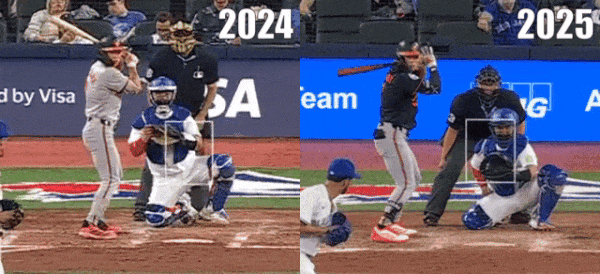
Leg kicks and toe taps are a timing mechanism and there is no one right answer. Leg kicks work for some players, toe taps work for others, and some even use both. They'll switch it up depending on the count, the pitcher's handedness, etc. With the leg kick last year, Holliday missed with 13.5% of his swings. This year it's down to 8.1% with the toe tap. (MLB average: 11.4%.)
It must be noted the toe tap is not completely new. It's something Holliday began toying with late last season. Sept. 27, specifically, is the day he debuted the top toe. That was the first game of the O's final series of the regular season. Holliday explained he gave the toe tap a try because Shohei Ohtani, one of the game's great hitters, uses one, so he figured it might work for him.
"Towards the end of last year, kind of messing with the toe tap, honestly just getting in the cage trying to hit like Shohei Ohtani one day," Holliday said during an MLB Network interview in spring training. "Kind of went with it and we were like hey, that looks pretty good. So I rolled it out there in the last few games of the season. It went pretty well. Kind of built off that in the offseason."
Holliday went 4 for 6 with a double and three walks with the toe tap in those final three regular-season games. That was enough to convince him to go all-in during the offseason and early this year. Whether the toe tap works and Holliday lives up to his potential is something we won't know the answer to for months, and really more like years. What we do know is he struggled when first called up last year, then replaced his leg kick with a toe tap. It's a game of adjustments and Holliday is making them.
The new and improved Bubic
Starting pitching was, once again, expected to be a strength for the Royals this season. Seth Lugo and Cole Ragans both finished top four in the AL Cy Young voting last season, plus the reliable Michael Wacha was given a new three-year extension. Michael Lorenzen was brought back to be a back-end stabilizer. That's a quality, four-deep rotation with a bona fide ace in Ragans.
Kansas City's rotation wild-card this year: Kris Bubic, who was so valuable as a reliever after returning from Tommy John surgery last July. In 2022, his last full and healthy season as a starter, Bubic threw 129 innings with a 5.58 ERA and underlying numbers that didn't give much reason for optimism. The Royals could have kept him in the bullpen this year, where they knew he'd be effective. Instead, they decided to give Bubic a chance to start.
Two starts into the new season -- only two starts -- the Bubic decision looks like a clear winner. He's allowed one run in 12 ⅔ innings while striking out 16. Bubic threw six shutout innings against the Brewers in his first start and held the Orioles to one run in 6 ⅔ innings last time out. He struck out eight batters in each start and has walked three batters total.
"He's got deception, he's got carry, he's got multiple plus pitches," Royals manager Matt Quatraro said following Bubic's last start (via MLB.com). "He's throwing the ball with a lot of confidence right now."
A funky lefty, Bubic's early success stems primarily from an improved changeup, and that improvement comes from lowering his arm slot. Statcast's arm angle data says Bubic has lowered his arm angle from 41 degrees last year (middle of the pack) to 38 degrees this year (lower than average). As a result of his new arm angle, Bubic has added:
- About two more inches of "rise" to his fastball, giving it more life at the top of the zone
- Close to five more inches of "drop" on his changeup, meaning it's diving further down
Bubic is also throwing a traditional slider -- a "gyro" slider that bites down more than it frisbees across -- in addition to his sweeper. The changeup has been the difference-maker though. Opponents have missed with more than half their swings against Bubic's new changeup this year, basically double his changeup whiff rate in 2022, his last season as a starter. He's also held hitters to an 84.8 mph average exit velocity. They're not making much contact, and the contact they do make is weak.
There is recent precedent for a pitcher lowering his arm angle and instantly unlocking a new level of performance. Sean Manaea did it just last season. The lower angle gives Bubic's fastball more life up in the zone, so it plays very well even at 91-93 mph, and the changeup has much more downward action. All it took was a little tweak in his arm angle. It's only two starts, and of course he won't continue with a 0.71 ERA, but Bubic looks new and improved, and potentially here to stay.
Home runs are up a bit but everything else is down
The first few weeks of the season are always a little weird in terms of run-scoring and the shape of the league's offense. Scoring is down, home runs are up, whatever. We do this every single season because what else are we supposed to talk about in April? The season's first month is nothing but the "this is happening, but is it real?" question packaged in different ways.
Compared to the last few years, home runs are up through the same time period this season, though not astronomically. Home runs are up relative to 2024 but are nowhere near the levels of 2019, the year all sorts of home run records were set. It feels like the ball is flying early this year. Overall though, the league homer rate is not wildly out of line with 2021-24.
Home runs are up a bit in the early going this year and, on the other end of the spectrum, other types of hits are down. We're seeing more homers but fewer singles, doubles, and triples. Here are the numbers entering Tuesday's action, plus the numbers at the same point (i.e. through the second Monday of the season) in the previous four seasons:
| Runs per game | HR per game | BA | BABIP | BA on contact | |
|---|---|---|---|---|---|
2021 | 4.49 | 1.18 | .233 | .287 | .319 |
2022 | 4.21 | 0.98 | .234 | .284 | .311 |
2023 | 4.63 | 1.13 | .248 | .298 | .329 |
2024 | 4.52 | 1.03 | .241 | .291 | .318 |
2025 | 4.40 | 1.09 | .238 | .284 | .314 |
BABIP is batting average on balls in play and does not include home runs because home runs are, technically, not in play. The defense doesn't have a chance to field them. Batting average on contact includes homers. That tells us how often a ball hit fair goes for a hit. BABIP and BA on contact remove at-bats that end in strikeouts, which is whey they're (much) higher than the league batting average.
Compared to the same point the last year, home runs are up slightly while run-scoring and base hits in general are down. Homers are replacing singles, doubles, and triples. Hitting a home run is the single most valuable thing a hitter can do. It's not a mystery why teams and hitters hunt them. At the same time, I'd argue the game losses something aesthetically with fewer non-homer base hits.
While looking at these numbers, keep in mind there are a few unusual years in there. There were still pandemic restrictions in place when 2021 started. Spring training was shortened in 2022 because of the lockout. 2023 was the first year with the pitch clock. That stuff all factored into the league's offensive environment to some extent. This isn't a perfect apples-to-apples comparison.
It is early in the season and offense always increases in the summer months. The league batting average finished in the .243 to .248 range every year from 2021-24, and BABIP finished in the .291 to .297 range. Offense is always depressed a bit in April. This year, offense has been homer heavy in part because the game is losing singles, doubles, and triples.
![[object Object] Logo](https://sportshub.cbsistatic.com/i/2020/04/22/e9ceb731-8b3f-4c60-98fe-090ab66a2997/screen-shot-2020-04-22-at-11-04-56-am.png)









